Among dedicated Sonic Youth fans, it’s long been something of an inside joke—“the Lee song.” Almost as a matter of ritual, it’s been the last song on side one of the LP, concealed deep within the glorious cacophony. Yet it always seemed to serve an artful purpose in the grand scheme of every Sonic Youth record. After a few doses of the band’s signature harrowing howl and the feral yowl of bizarro-tuned Jazzmasters and Jaguars, the Lee song was a breather, the eye of the storm, an emotive touch, and often a touch of pop/rock classicism amid the cyclone swirl. Many Lee songs are classics in the Sonic Youth canon—“ Mote” from Goo, “Karen Koltrane” from A Thousand Leaves, “In the Kingdom” from Evol. And they gave every Sonic Youth album a depth, weight, and beautiful counterpoint to the band’s more unbridled side.
Sonic Youth’s future is now uncertain. Lee Ranaldo the songwriter, however, may be just hitting his stride. The evidence is Between the Times and the Tides, a collection of 10 tunes that encapsulates both the love of melody that the young Ranaldo loved in the work of the Beatles and Crosby, Stills, Nash & Young and the sense of adventure and abandon that made Sonic Youth one of the most vital and original bands of the last 30 years.
Between the Times and the Tides began as a solo effort, but it quickly evolved into a band effort featuring one the nastiest set of ringers you could ever swindle: Former underground hero, now-Wilco ace Nels Cline and New York avant lifer Alan Licht support Ranaldo on guitar, organist John Medeski of Medeski Martin & Wood contributes a lush Pink Floyd-ian bed of Farfisa and Hammond organ, and Sonic Youth drummer Steve Shelley acts as rhythm anchor. They are the bedrock for a set of songs teeming with guitar textures that’ll have listeners doing aural double takes—and that will undoubtedly surprise many Sonic Youth fans. It’s a remarkable union of sonics and song.
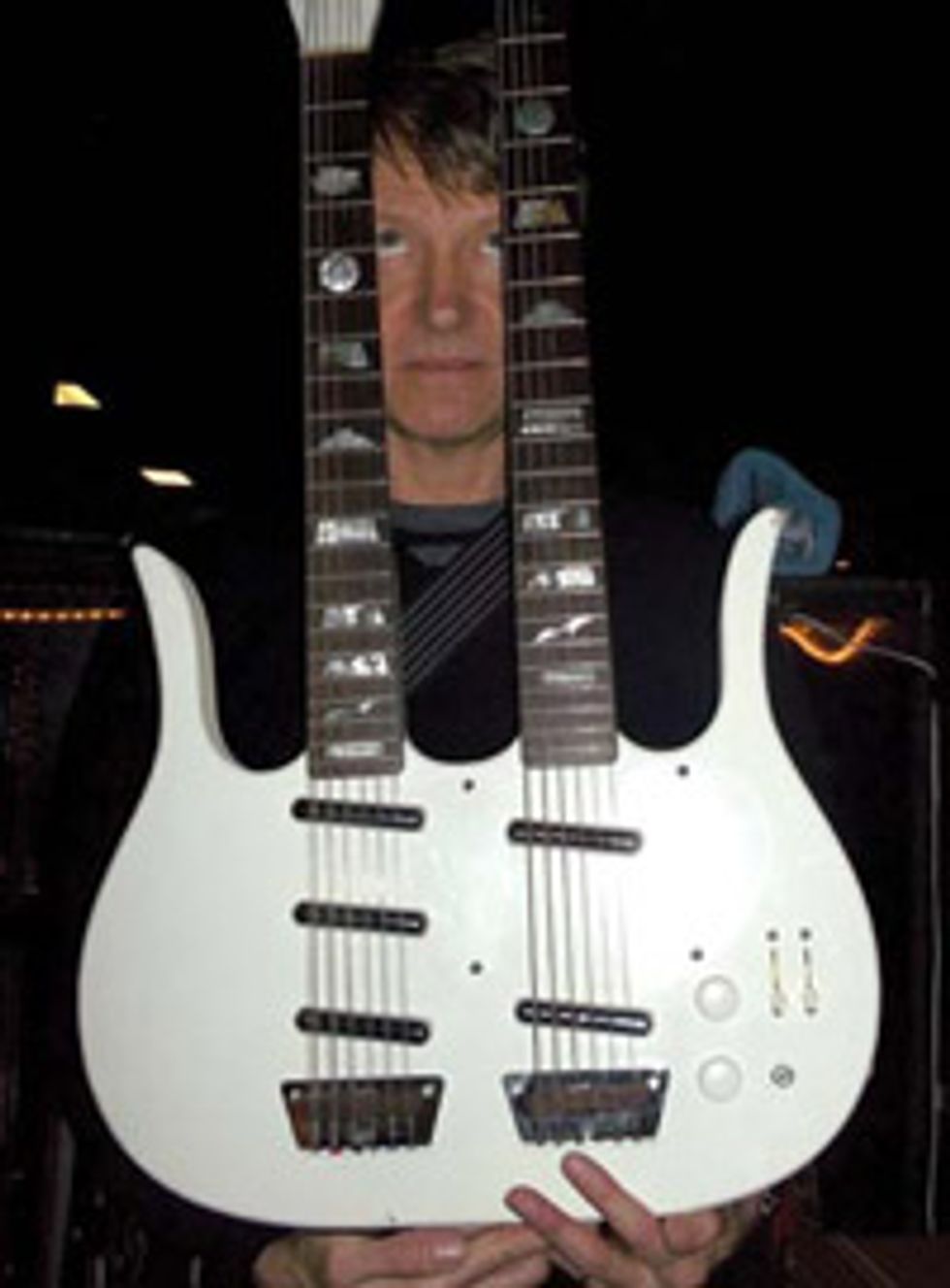
When you’ve spent the last 30 years changing the vocabulary of the electric guitar, you can call on some heavy friends. Lee Ranaldo called on some of the heaviest for Between the Times and the Tides. To fans who’ve come to know Nels Cline through his high-profile work with Wilco in the last half decade, it may be a surprise to know that Cline spent years as the lowkey guitar king of the free-jazz improv underground. It should come as no surprise, then, that Cline and Ranaldo— who has actively championed the avant underground for decades—have collaborated in improvisational situations before, including 2001’s Four Guitars Live gig with Thurston Moore and Carlos Giffoni. While motoring between Wilco gigs, Cline shared some thoughts on working with his old buddy, mentor, and brother in sonic mayhem.
It’s cool to be working with Lee
again, I gather?
I’m really proud to be on the record.
I’ve admired Lee’s work with Sonic
Youth, but also with Kevin Drumm and
Text of Light. So I was thrilled. But it’s
funny, I always seem to be the last guy
to overdub on a record, and that happened
here, too. I just went over to the
studio in Hoboken [New Jersey] with
the idea to play on a couple things to
see how it went, and it just kept going.
When I listened to the record, I realized
I played on about everything! The
record is so amazing sounding, though.
It has such a beautiful roar to it. To hear
the way the guitars all sound together
and how strong the songs are—hearing
it made me emotional, frankly. To be
lucky enough to be part of that sound
got to me.
You seem to have such admiration—
almost a gratitude, it seems—for
what Sonic Youth’s work has meant
to you personally.
That’s very true. The influence Sonic
Youth had on me, personally, is almost
incalculable. Certainly, what they did
with guitars was completely intoxicating
and attractive to me. I never
thought about playing or guitar or
sound the same way after I experienced
them. So that’s pretty huge.
When I first got into them, around ’83 and Confusion Is Sex, I got so into the whole aesthetic and the way the band gelled. I thought, “This is perfection … how can I create something that’s a complete entity like this.” By the time they got to Daydream Nation and became this kind of rock ’n’ roll juggernaut, that was just so huge in every way—it was hard to not be impressed.
How do you view Sonic Youth’s influence
in the larger musical world?
Well, in the ’90s when you started
hearing bands like Unwound and
Polvo doing things with detuned guitars
and eighth-note rhythm-section
things, you could spot a very direct
influence. There was also a certain outlook
on culture—the way they married
high and low culture—that felt artful
and humorous at the same time. But
mostly it was just that the music was
excruciatingly beautiful, but not in the
sense most people perceive beautiful—
and that gave people a different angle
from which to hear music in general.
A lot of that is in what they did with
overtones. I’m not sure many people
have been able to touch their sensitivity
or their sense of how to create
intoxication with guitar overtones. But
the way that made folks look at harmonic
information is really influential,
even if fewer people hear or see that
than the bigger pop culture influence.
Society isn’t always so kind to the
avant-garde. Is it weird, after so
many years of toiling in the avantgarde
scene, to look up and think,
“Whoa! There’s Lee … there’s Alan
Licht … we’re all still around!”?
Yeah, man! Absolutely. I’m so thankful.
But when I think about how frail
the body can be and how hard basic
survival can be, yeah, to get to sit
there and work out guitar sounds
with Lee or work with Thurston—
it’s not lost on me for a second how
lucky I am. The avant-garde has less
presence in the media right now, but
that’s certainly not for lack of effort
from Lee and Sonic Youth. Their
efforts to expose the world to the
avant-garde are totally heroic, but
also totally natural.
After playing with Lee in a lot of
improvised contexts, was it weird
to work in the realm of actual
songs and compositions?
No, not at all. I used to grapple with
the implications of occupying those
two divergent streams, but I don’t
really live in that mode of thought
anymore. And knowing Lee and
Thurston over the years and watching
how open and spontaneous they
can be in any world, in any way,
that’s helped immensely.
“Xtina as I Knew Her” is a very
strong example of those two worlds
colliding. It’s deep in abstract textures
and ripping solo work.
Well, Lee was so relaxed—it was just a
very relaxed situation. He just let me
come up with whatever idea I wanted,
directing me just a little. And then,
because we were using Pro Tools, he
could grab whatever parts he liked.
But I was surprised how much he
took and how audible he made it.
Do you have any favorite moments
on the record?
I listened to it recently in the car and
I didn’t want to get out of the car. I
think that’s when I got really emotional
about it. I grew up listening to
music in the car in L.A., and getting
that vibe and all the moods—from
the heavy riffage to the lap steel—
was really cool. There’s both drama
and modesty in it, and things like
the lap steel parts that were so spontaneous
and inspired.
Why did this album happen now—did
you feel like things were fermenting, laying
dormant?
Things weren’t really fermenting. They got
rolling really quickly, and it just kept going
from start to finish. I’ve given up asking
myself why it happened the way it did. It
was very naturalistic and unforced—and
really fun. The songs had a genesis in an
invitation to do an acoustic show in the
south of France. I figured I’d do some Sonic
Youth songs, but then this song popped up
out of working on those, and then a few
more came out of that, and I started thinking
maybe I’d do a solo acoustic record with
some singing. But one thing led to another,
and the next thing I knew Steve was playing
on some things that sounded like band stuff.
Then Irwin [Menken, bassist] came over
and it just happened. It was pretty magical.
I was really excited to get Alan Licht— who I play with in a lot of different improvisational contexts—in there, too. He’s an amazing guitar player, and I never get to hear him play straight-ahead leads—but he’s so good at it, it’s incredible. Nels and John Medeski really round things out on guitar and organ—in a monster way, obviously.
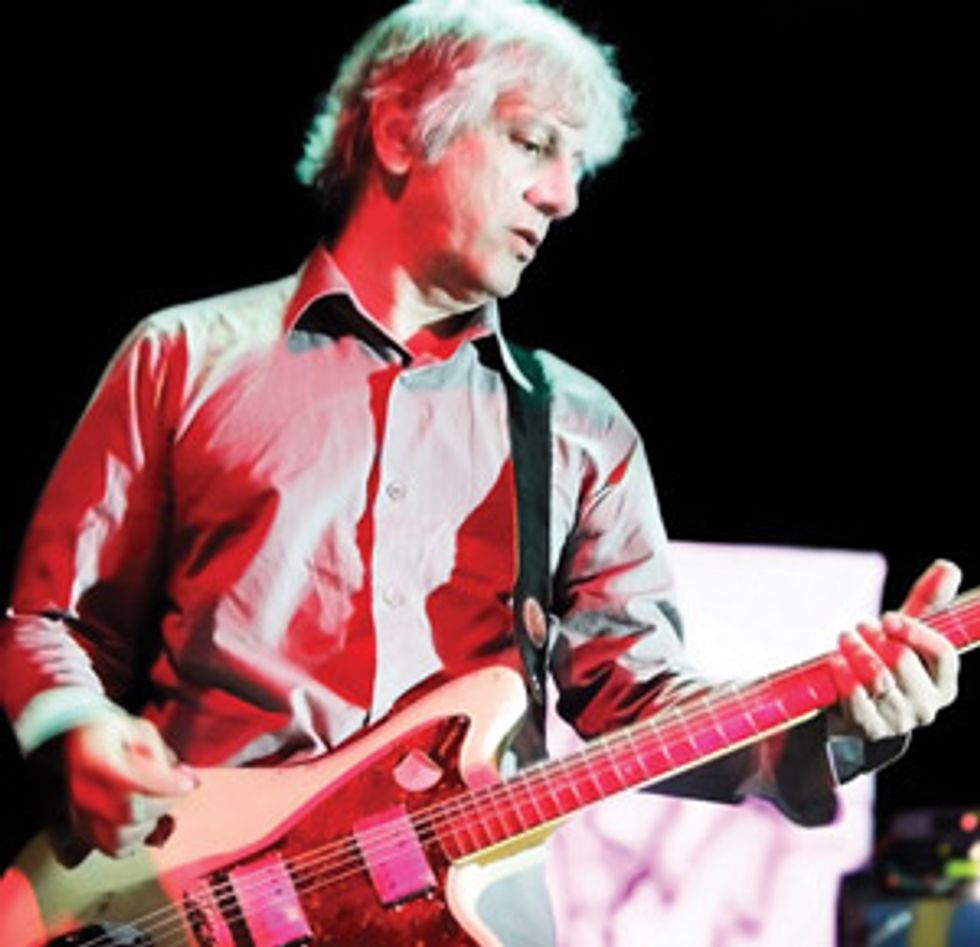
Given that this is your first foray into
solo singer-songwriter work, did you
approach the guitar work differently than
you would with Sonic Youth?
Even though I overdubbed some leads, I
was really just focusing on playing rhythm
guitar and letting Alan or Nels take solos or
countermelodies. I wanted to do less. The
songs were written on acoustics, and some
had intricate picking patterns that were
integral to the song, so I did a lot more
purely rhythm work than I might have in
Sonic Youth.
Keith Richards once talked about dreading
playing alone after being in a twoguitar
band for so long. Given how many
years you’ve been locking horns with
Thurston [Moore] in Sonic Youth, did
you share that apprehension?
I didn’t really just because they were songs
I’d started playing alone. But I also knew I
didn’t want to be the only guitar player, and
I thought Alan and Nels could really add
something to these songs. But there’s also
a lot of keyboard, which sets it apart from
Sonic Youth and changes what the guitars do
to some extent. It changes that dynamic and
the way we all approached the guitar layers.
You’ve worked with Alan and Nels in
improv situations for years. Now you’re
working in the context of compositions
and songs. Did you react any differently
to each other?
It wasn’t different at all, which was so cool.
They were just so inventive with the simple
demos I gave them. Alan came back with
these parts that were exactly what you’d
want a second guitar to play—picking
when I’m strumming, strumming when
I’m picking. His parts really locked the
songs together. And Nels did coloration on
everything from smoking leads to loops and
stuff—just incredible.
Parts of it really evoke a Neil Young/
Steven Stills- or Tom Verlaine/Richard
Lloyd-style interplay.
Those are such major touchstones for
me. Alan actually played with Tom, so he
knows that dynamic well. But, yeah, getting
in that territory is a thrill—especially
with Alan and Nels, who can really do
anything between them.
At times, the tunes have a David Crosbyor
Joni Mitchell-type feel—there’s often a
melancholy feel but also something that’s
simultaneously very open and very
sturdy in the guitar parts.
So much of that is the tunings—and there
are a lot of them on this record. And it
definitely came from listening to Crosby
and Joni. I mean, there are parts of this
record that I actually referred to as “the
Joni part” when we were running through
them. I played almost entirely in alternate
tunings, and Alan is exclusively in standard,
but they fit together very well. Nels
played some drop tunings for lap steel,
but otherwise he was in standard, too.
Did you use any new tunings that you
hadn’t tinkered with elsewhere?
Almost every one is new to this record.
It’s actually the big problem, because I’ll
have to take more guitars on the road
than I wanted to. There are six or seven
tunings for 10 songs. There’s only one
Sonic Youth tuning that goes back several
years. Hopefully, I won’t have to bring
more than four guitars, or so. I actually
did a song in standard, which is maybe
the only song I’ve done in standard
since the very first Sonic Youth record. I
played in D–D–A–E–A–D [string gauges
.013, .017, .028, .032, .044, .054] on
“Angles,” Shouts,” and “Stranded.” On
“Xtina” and “Off the Wall,” I played in
D–A#–D–F–C–A# [.017, .020, .026,
.032, .047, .054]. And on “Hammer
Blows,” I used C–G–C–C–C–G [.018,
.014, .028, .035, .045, .056].
Do you still work with a lot of unisons?
I do, but I was discovering most of these
tunings as I wrote. I wasn’t looking for
anything in particular. The song would
often steer things in a certain direction.
You’ve always seemed to have a feel for
spare, impressionistic pieces, like
“Hoarfrost” [from SY’s A Thousand
Leaves]—pieces that feel pretty solitary.
Is there an appeal in those structures as a
guitar player?
I do love to hear a lot of tonality and the
interplay of notes. That comes from playing
a lot of acoustic guitar, which I’ve always
done. And those spare arrangements are a
great way to get down deep into that interplay.
We rarely let ourselves get as delicate as
“Hoarfrost” in Sonic Youth, though. But
that might be my favorite recording of one of
my songs in the whole Sonic Youth catalog.
There’s a lot of guitar-generated ambience
on this record.
That came from layering the three of us.
I knew what I wanted for a rhythm bed,
but then Alan and Nels were so good with
countermelodies that there was a lot of stuff
to play with. So it came down to this really
fun process of layering and arranging in the
mix—“put those two here, take me out there,
then me and Alan there”—those kinds of
things. I really, really enjoyed that part of it.
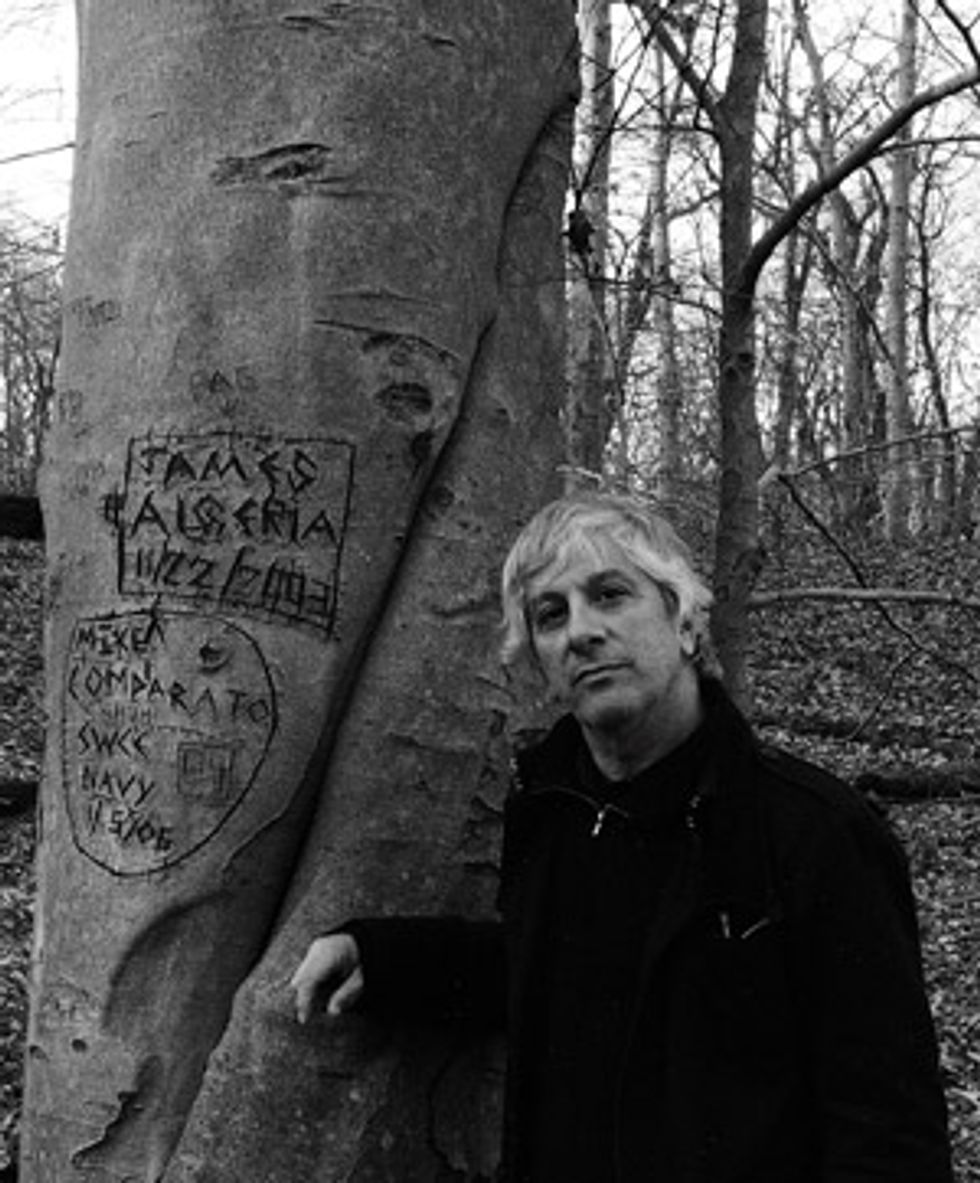
“Xtina as I Knew Her” seems to have very
deep layers.
That one is the most layered. It was just a
rhythm track, then Alan came in and put
some chordal stuff on it and very purposefully
didn’t play in some sections. Then Nels
put on the fiery riffs and we traded back
and forth on the leads—mine were more
Neil Young-like and his were more fluid.
But as dense as it sounds, it’s not quite as
wall-of-sound as it might seem. It’s just a
few guitars playing off a rhythm section and
then John Agnello, who mixed the thing,
used a lot of short delay to spread the tracks
out a bit—it almost makes it kind of a blur.
Did you use any new gear or consciously
try to differentiate this record from a Sonic
Youth record from a sound perspective?
No, I didn’t think about it like that. I
played a lot of my “Jazzblasters” [Fender
Jazzmasters customized with Fender
Wide Range humbuckers from old Tele
Thinlines], which have a very strong
familiarity for me. I played one new guitar—
a Jarrell JZH-1x, which is pretty cool.
I used that on the standard-tuning stuff. It
holds standard tuning really well and is a
very nice-playing guitar.
Effects-wise, the big change is that I’m using so much less. I used an Ibanez AD-80 delay and a few distortion pedals—a BJF Electronics Honey Bee and a Voodoo Lab Sparkle Drive—and that’s pretty much it. I’m not even using a loop pedal, which is unusual for me. Alan is doing much more of the coloration in the live setting, so he has a lot more pedals than me. My rig is really pretty simplified, and that’s nice for a change.
You’ve cultivated a very distinct tone over
the last 10 years or so.
Thurston and I have really dialed in our
tones in recent years—though I think our
real accomplishment was that we got better
at mixing our guitars together. And we were
so good at it in a way that I really haven’t
thought about it in a long time—whose
tone was whose. I had just started to hear
things as this bigger whole.
You’ve mentioned in the past that you’ve
always liked Fender amps for the way
they project. Are you still working primarily
with Fender amps?
I could never play through a Marshall, really,
because I feel like it throws the sounds
away from you. They’re good onstage in
some instances, because they almost feel
like they throw the sound past you. Fenders
always seem to bloom right there in front
of you. They’re loud in a different way—a
more experiential way. In terms of coloration,
I find they just sound better. They
have that nice, pleasing roundness to them.
Right now, though, I’ve been looking to play through smaller amps. We’ve been trying a lot more 20-watt amps and things like that. For a long time, Super Reverbs have just been the beginning and end of things for me. They just sound great every time. But this time I looked at a lot of stuff I’ve never used before, and I’m still in testing mode. Sonic Youth’s guitar tech, Eric Baecht, is out on tour with Wilco doing Nels’ stuff, so he sends me pictures of what’s out there and what they’re messing with. Jeff Tweedy was playing out of a Tex [a Tex Amps Texosound Bernie 15] that looked really cool, and I was like, “Whoa, what’s the Tex?” So I hooked up with those people and that’s been cool. I’ve used a Fender Deluxe. We’ve also tried some stuff by Victoria—a pretty cool amp that mimics a tweed Deluxe. We tried out the ZT Lunchbox, which Nels speaks very highly of, and I’m going to try out the larger version of that [the Club]. I’m playing out of an Ampeg Jet, and I also tried [Wild Flag vocalist/guitarist] Carrie Brownstein’s 100-Watt Music Man. That sounded pretty cool, too.
There’s a lot of emotion in these songs—
and great imagery, too. Visual art—especially
photography and film—is such
a huge part of your life these days. Are
there similarities between that and music
that reinforce each other?
They must. Strangely, a lot of it is about
decision-making and process. They’re surprisingly
similar in that way. I’m getting to
a place where I’m pretty comfortable with
the process of both, and that’s when unexpected,
sometimes more natural things happen.
It certainly did with this record.
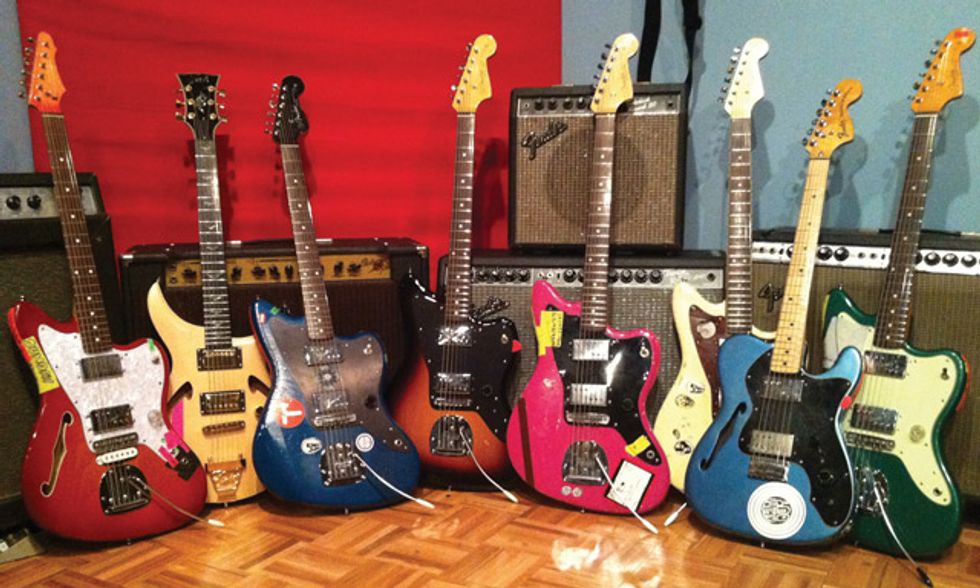
Lee Ranaldo's Gear
Guitars: Fender Lee Ranaldo Signature Jazzmaster (third from left), various Fender “Jazzblasters” (Jazzmasters with Wide Range humbuckers), Saul Koll Jazzmaster-style semi-hollowbody (far left, note the behind-the-bridge pickup), Jarrell JZH-1x (second from left), Fender Telecaster Deluxe (second from right)
Amps: Fender Super Reverb, Fender Deluxe, Ampeg Jet, ZT Lunchbox
Effects: Ibanez AD-80 analog delay, BJF Electronics Honey Bee, Voodoo Lab Sparkle Drive
Strings and Picks: Ernie Ball strings (various gauges, depending on tuning), Jim Dunlop picks
YouTube It
For a taste of Lee Ranaldo’s screaming sonic mayhem,
check out the following clips on YouTube.
The fi rst gig with Ranaldo’s new band in Brooklyn in
October 2011. Here the band takes on standout “Xtina As
I Knew Her”. Alan Licht and Ranaldo each take a lead.
“Mote” is one of the strongest Lee Ranaldo songs in the
Sonic Youth catalog. Here the band works out a pretty
screaming version complete with delay and feedback
breakdown at a European festival in the early 2000s.
“What We Know” was a highlight on the last Sonic Youth
LP, The Eternal—a perfect example of how Lee and
Sonic Youth could unite the tuneful and the howling.


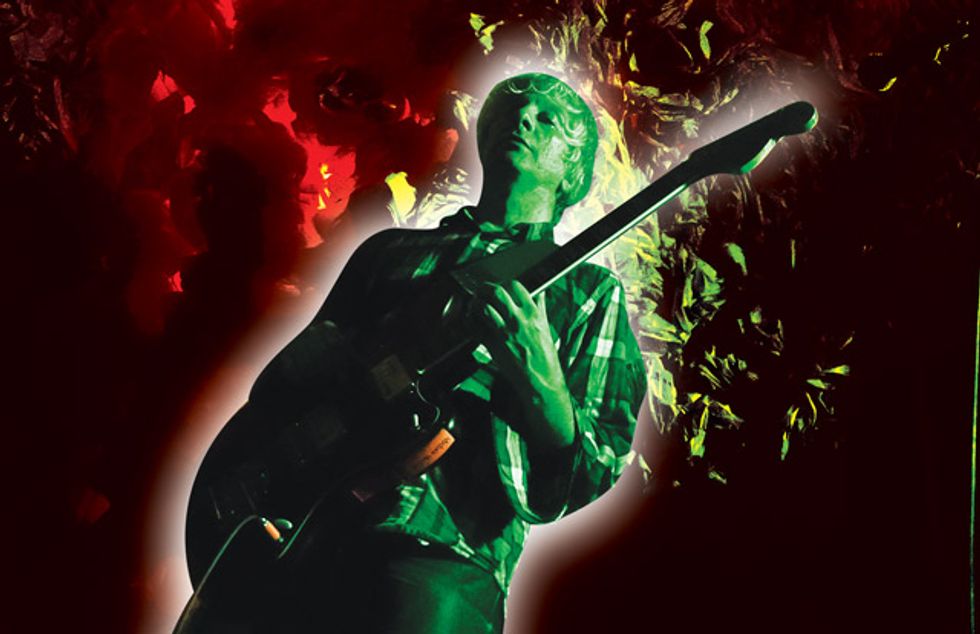











![Rig Rundown: Russian Circles’ Mike Sullivan [2025]](https://www.premierguitar.com/media-library/youtube.jpg?id=62303631&width=1245&height=700&quality=70&coordinates=0%2C0%2C0%2C0)










![Rig Rundown: AFI [2025]](https://www.premierguitar.com/media-library/youtube.jpg?id=62064741&width=1245&height=700&quality=70&coordinates=0%2C0%2C0%2C0)




















 Zach loves his Sovtek Mig 60 head, which he plays through a cab he built himself at a pipe-organ shop in Denver. Every glue joint is lined with thin leather for maximum air tightness, and it’s stocked with Celestion G12M Greenback speakers.
Zach loves his Sovtek Mig 60 head, which he plays through a cab he built himself at a pipe-organ shop in Denver. Every glue joint is lined with thin leather for maximum air tightness, and it’s stocked with Celestion G12M Greenback speakers.











